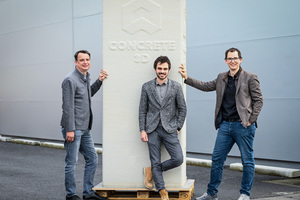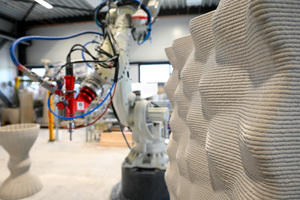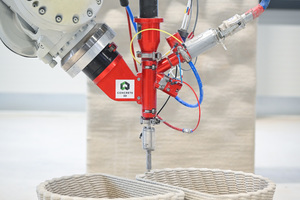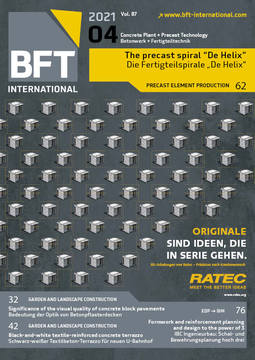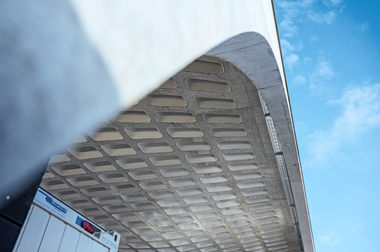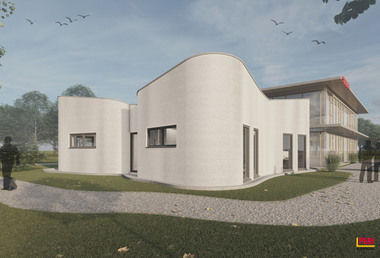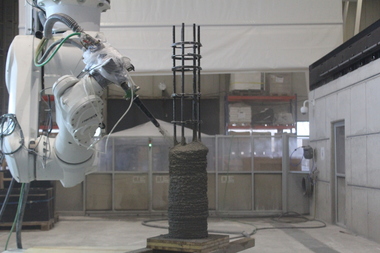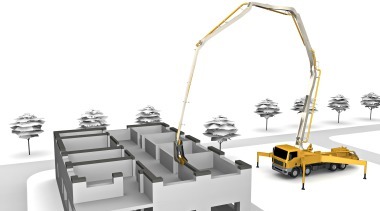Vorarlberg company is a pioneer 3D printing with concrete
Austrian companies Jolo Betonfertigteile and Tomaselli Gabriel Bau established a joint venture for 3D printing with concrete: Concrete 3D GmbH operates its head office in Nüziders in the Austrian Vorarlberg region and is one of the first businesses worldwide that use 3D-printed concrete components in a real-life construction environment. The two shareholders invested about €300,000 in the plant and successfully completed the pilot phase at the beginning of February. They are now heading towards market entry.
Concrete 3D printing has previously been restricted to research and only a small number of landmark projects. “This dynamic and exciting technology opens up an enormous potential. We want to be one of the early adopters of this innovation.” This is how the two managing directors, Markus Loacker, of Jolo Betonfertigteile, and Philipp Tomaselli, of Tomaselli Gabriel Bau, describe their ambitious goal. The two companies are contributing their expertise to the ongoing development process, and the first 3D-printed concrete components already made their way into projects managed by the shareholders. “Thanks to our partnership, the development of our products goes hand in hand with their use in actual projects,” Loacker adds.
Each of the two companies holds a 50% share in Concrete 3D GmbH. Having completed several pilot projects in the past three months, they are currently heading towards full market entry in March. “We will be gaining additional experience while collaborating with pilot customers in our region, followed by step-by-step expansion to all German-speaking countries,” says division manager Michael Gabriel, looking forward to the launch.
3D printing opens up new dimensions
Loacker and Tomaselli have thoroughly dealt with this technology in the past two years, with the main aim to find a suitable production line. They invested about €300,000 in the plant, which includes a six-axis industrial robot covering a radius of 2.8 m. A printing nozzle deposits the concrete layers to a thickness of 1 to 3 cm, and a mortar pump ensures continuous material feed. Hardware and software components complement the system.
The CAD plans fed into the system determine the items to be printed. For instance, printing a flowerpot with a diameter and height of 1 m takes about five minutes. Yet the opportunities are virtually unlimited: “3D printing opens up completely new dimensions. What was previously unthinkable in the world of concrete – free-form production without formwork – is now coming true. We are able to produce complex shapes and forms, and even in series,” explains Michael Gabriel. “Digitization, industrialization and productivity – these are major areas to be explored in the construction industry in order to make the sector future-proof. 3D printing merges all three aspects while also enabling customization,” adds Philipp Tomaselli.
One positive side effect of 3D printing is that it can reduce the prefabricated concrete elements to the dimensions required in structural terms, which saves material and costs while reducing the impact on our climate.
Successfully tested under real-life conditions
Concrete 3D will initially focus on producing semi-precast elements, façade panels, concrete blockouts and furniture. 3D-printed façade panels open up new design options for architects. Prefabricated blockouts make it possible to save costs when casting walls and floors, thus eliminating the need for using expensive wooden formwork on-site. “Lower costs, reduced material consumption and less waste: concrete 3D printing makes the construction industry more sustainable,” according to the firm conviction of Philipp Tomaselli. Jolo Betonfertigteile and Tomaselli Gabriel Bau are already using 3D-printed blockouts in their projects.
Another primary aim of the newly established business is to raise awareness of the new opportunities among market participants. “Many people just can’t imagine that concrete can be printed, let alone the wide range of products made possible by it,” Markus Loacker adds. “We need to demonstrate these options to construction contractors, architects and structural designers.”

